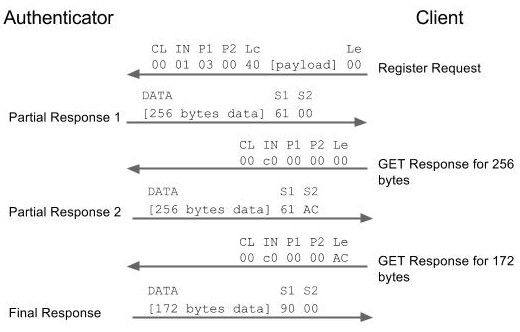Abstract
The FIDO U2F framework was designed to be able to support multiple authenticator form
factors. This document describes the communication protocol with authenticators over
Near Field Communication (NFC).
Status of This Document
This section describes the status of this document at the time of its publication.
Other documents may supersede this document. A list of current FIDO Alliance publications and the
latest revision of this technical report can be found in the FIDO Alliance specifications index at
https://www.fidoalliance.org/specifications/.
This document was published by the FIDO Alliance as a Implementation Draft.
This document is intended to become a FIDO Alliance Proposed Standard.
If you wish to make comments regarding this document, please
Contact Us.
All comments are welcome.
This Implementation Draft Specification has been prapared by FIDO Alliance, Inc. Permission is
hereby granted to use the Specification solely for the purpose of implementing the Specification. No rights
are granted to prepare derivative works of this Specification. Entities seeking permission to reproduce
portions of this Specification for other uses must contact the FIDO Alliance to determine whether an
appropriate license for such use is available.
Implementation of certain elements of this Specification may require licenses under third party intellectual
property rights, including without limitation, patent rights. The FIDO Alliance, Inc. and its Members
and any other contributors to the Specification are not, and shall not be held, responsible in any manner
for identifying or failing to identify any or all such third party intellectual property rights.
THIS FIDO ALLIANCE SPECIFICATION IS PROVIDED “AS IS” AND WITHOUT ANY
WARRANTY OF ANY KIND, INCLUDING, WITHOUT LIMITATION, ANY EXPRESS OR IMPLIED
WARRANTY OF NON-INFRINGEMENT, MERCHANTABILITY OR FITNESS FOR A
PARTICULAR PURPOSE.
1. Notation
Type names, attribute names and element names are written as code.
String literals are enclosed in “”, e.g. “UAF-TLV”.
In formulas we use “|” to denote byte wise concatenation
operations.
DOM APIs are described using the ECMAScript [ECMA-262] bindings
for WebIDL [WebIDL].
UAF specific terminology used in this document is defined in
[FIDOGlossary].
1.1 Key Words
The key words “MUST”, “MUST NOT”, “REQUIRED”, “SHALL”, “SHALL NOT”,
“SHOULD”, “SHOULD NOT”, “RECOMMENDED”, “MAY”, and “OPTIONAL” in this
document are to be interpreted as described in [RFC2119].
2. Protocol
The general protocol between a FIDO client and authenticator over NFC
is as follows:
- Client sends an applet selection command
- Authenticator replies with success
- Client sends a command for an operation (register / authenticate)
- Authenticator replies with response data or error
The Authenticator MUST reply to all commands within 800ms.
3. Framing
The NFC protocol SHALL NOT use any additional framing (unlike the USB
HID protocol, for example). Instead, messages sent to an NFC
authenticator SHALL follow the U2F raw message format as defined in
[U2FRawMsgs] in the bibliography. In the NFC protocol, either
short or extended length APDU encoding is allowed.
4. APDU Length
Some responses may not fit into a short APDU response. For this reason,
U2F authenticators MUST respond in the following way:
- If the request was encoded using extended length APDU
encoding, the authenticator MUST respond using the extended length
APDU response format.
- If the request was encoded using short APDU encoding,
the authenticator MUST
respond using ISO 7816-4 APDU chaining (see Section A.4).
See below for an example:

5. Applet selection
A FIDO client SHALL always send an applet selection command to begin
interaction with a FIDO authenticator via NFC. The structure of the
applection command SHALL follow the same APDU structure as in the
raw message format mentioned above.
The FIDO U2F AID consists of the following fields:
| Field | Value |
|---|
RID | 0xA000000647 |
AC | 0x2F |
AX | 0x0001 |
As a result, the command for selecting the applet using the FIDO U2F
AID is:
| Field | Value |
|---|
CLA | 0x00 |
INS | 0xA4 |
P1 | 0x04 |
P2 | 0x00 |
LEN | 0x08 |
DATA | 0xA0000006472F0001 |
In response to the applet selection command, the FIDO authenticator
SHALL reply with its version string in the successful response.
In this writing, the version string is "U2F_V2", hence a successful
response to the applet selection command would consist of the following
bytes:
0x5532465F56329000
6. Implementation Considerations
Correct and reliable functioning of the NFC U2F authenticator
requires a reliable contactless communication between the NFC U2F
authenticator and the contactless reader device. However, there are
currently several relevant specifications describing the contactless
proximity interface often summarized under the term “NFC”.
In order to guarantee interoperability, the contactless interface
of the NFC U2F authenticators and the various implementations of
contactless readers should follow one of the following standards:
- NFC U2F authenticators should be designed according to
ISO/IEC 14443 or ISO/IEC 18092. These standards are commonly used
for FIDO authenticators, eID, passports, public transport fare media
etc. It is highly recommended to test and certify the conformance of
the authenticator to ISO/IEC 14443 or ISO/IEC 18092 by an
independent party.
- For mobile use of FIDO authentication, the reader
functionality of NFC-enabled mobile devices will typically be used
for NFC U2F authenticators. Mobile devices should be designed
according to NFC Forum Analog specification v2.0 or later. NFC Forum
also offers testing and certification.
The testing and certification for the above listed specifications
will ensure interoperability of NFC U2F authenticators and NFC mobile devices.
Generally, all reader devices that may be used with unspecific types
of NFC U2F authenticators (see a.) should be conformant to NFC Forum
analog specification.

